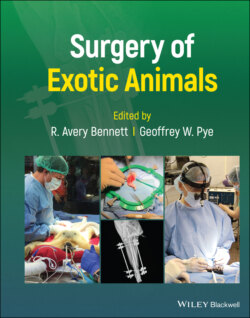Читать книгу Surgery of Exotic Animals - Группа авторов - Страница 71
The Operating Microscope
ОглавлениеThe surgical microscope is considered by many surgeons to be the gold standard of operative optical aids, a mandatory instrument for performing many technically demanding procedures and an indispensible teaching tool (McManamny 1983; Pieptu and Luchian 2003; Al‐Benna 2011). A standard operating microscope is capable of magnifying an image from 6 to 40×, enabling many procedures that would otherwise be impossible to perform (Mungadi 2010; Stanbury and Elfar 2011). With the size amplification afforded by the microscope, visualization of tissue anatomy, pathology, color, and character is enhanced; suture and instrument placement is more precise; and small, bleeding vessels and other abnormalities are more readily appreciated (Bennett 2000b; Mungadi 2010). Although the degree of precise manipulation and dexterity possible with magnification is far superior to that achieved with the unaided eye, performing accurate surgical maneuvers with extensive magnification requires practice (Carr and Castellucci 2010; Eivazi et al. 2015). Operating microscopes are expensive and can be cumbersome requiring intimate familiarity with their precision parts to permit proper and efficient use during surgery (McManamny 1983; Mungadi 2010).
Figure 3.5 Field of view is the extent of the operating field seen in focus through the optical system. Here, the field of view is contained within the lighted circle as seen external to the microscope.
The optical system of an operating microscope consists of a binocular head containing the eyepieces, lenses, prisms, and magnification changer; the objective lens; an illumination source; a suspension system; and a foot pedal or handpiece for controlling magnification, focus, and x–y position of the objective lens (Carr and Castellucci 2010; Cordero 2014). During surgery, a skilled surgeon must adjust the level of magnification frequently as tissues are manipulated and sutures are passed and tied (Eivazi et al. 2015). For this reason, the author prefers a foot pedal to a handpiece for manipulation of magnification and x–y settings (Figure 3.6). Using a foot pedal permits the surgeon to maintain a desired position with instruments in both hands without disrupting the flow of surgery (Carr and Castellucci 2010).
